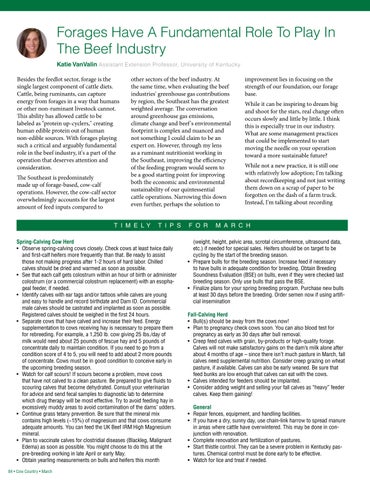Forages Have A Fundamental Role To Play In The Beef Industry Katie VanValin Assistant Extension Professor, University of Kentucky Besides the feedlot sector, forage is the single largest component of cattle diets. Cattle, being ruminants, can capture energy from forages in a way that humans or other non-ruminant livestock cannot. This ability has allowed cattle to be labeled as "protein up-cyclers," creating human edible protein out of human non-edible sources. With forages playing such a critical and arguably fundamental role in the beef industry, it's a part of the operation that deserves attention and consideration. The Southeast is predominately made up of forage-based, cow-calf operations. However, the cow-calf sector overwhelmingly accounts for the largest amount of feed inputs compared to
other sectors of the beef industry. At the same time, when evaluating the beef industries' greenhouse gas contributions by region, the Southeast has the greatest weighted average. The conversation around greenhouse gas emissions, climate change and beef 's environmental footprint is complex and nuanced and not something I could claim to be an expert on. However, through my lens as a ruminant nutritionist working in the Southeast, improving the efficiency of the feeding program would seem to be a good starting point for improving both the economic and environmental sustainability of our quintessential cattle operations. Narrowing this down even further, perhaps the solution to
T I M E LY
T I P S
Spring-Calving Cow Herd • Observe spring-calving cows closely. Check cows at least twice daily and first-calf heifers more frequently than that. Be ready to assist those not making progress after 1-2 hours of hard labor. Chilled calves should be dried and warmed as soon as possible. • See that each calf gets colostrum within an hour of birth or administer colostrum (or a commercial colostrum replacement) with an esophageal feeder, if needed. • Identify calves with ear tags and/or tattoos while calves are young and easy to handle and record birthdate and Dam ID. Commercial male calves should be castrated and implanted as soon as possible. Registered calves should be weighed in the first 24 hours. • Separate cows that have calved and increase their feed. Energy supplementation to cows receiving hay is necessary to prepare them for rebreeding. For example, a 1,250 lb. cow giving 25 lbs./day of milk would need about 25 pounds of fescue hay and 5 pounds of concentrate daily to maintain condition. If you need to go from a condition score of 4 to 5, you will need to add about 2 more pounds of concentrate. Cows must be in good condition to conceive early in the upcoming breeding season. • Watch for calf scours! If scours become a problem, move cows that have not calved to a clean pasture. Be prepared to give fluids to scouring calves that become dehydrated. Consult your veterinarian for advice and send fecal samples to diagnostic lab to determine which drug therapy will be most effective. Try to avoid feeding hay in excessively muddy areas to avoid contamination of the dams’ udders. • Continue grass tetany prevention. Be sure that the mineral mix contains high levels (~15%) of magnesium and that cows consume adequate amounts. You can feed the UK Beef IRM High Magnesium mineral. • Plan to vaccinate calves for clostridial diseases (Blackleg, Malignant Edema) as soon as possible. You might choose to do this at the pre-breeding working in late April or early May. • Obtain yearling measurements on bulls and heifers this month 84 • Cow Country • March
F O R
improvement lies in focusing on the strength of our foundation, our forage base. While it can be inspiring to dream big and shoot for the stars, real change often occurs slowly and little by little. I think this is especially true in our industry. What are some management practices that could be implemented to start moving the needle on your operation toward a more sustainable future? While not a new practice, it is still one with relatively low adoption; I'm talking about recordkeeping and not just writing them down on a scrap of paper to be forgotten on the dash of a farm truck. Instead, I'm talking about recording
M A R C H
(weight, height, pelvic area, scrotal circumference, ultrasound data, etc.) if needed for special sales. Heifers should be on target to be cycling by the start of the breeding season. • Prepare bulls for the breeding season. Increase feed if necessary to have bulls in adequate condition for breeding. Obtain Breeding Soundness Evaluation (BSE) on bulls, even if they were checked last breeding season. Only use bulls that pass the BSE. • Finalize plans for your spring breeding program. Purchase new bulls at least 30 days before the breeding. Order semen now if using artificial insemination Fall-Calving Herd • Bull(s) should be away from the cows now! • Plan to pregnancy check cows soon. You can also blood test for pregnancy as early as 30 days after bull removal. • Creep feed calves with grain, by-products or high-quality forage. Calves will not make satisfactory gains on the dam’s milk alone after about 4 months of age – since there isn’t much pasture in March, fall calves need supplemental nutrition. Consider creep grazing on wheat pasture, if available. Calves can also be early weaned. Be sure that feed bunks are low enough that calves can eat with the cows. • Calves intended for feeders should be implanted. • Consider adding weight and selling your fall calves as “heavy” feeder calves. Keep them gaining! General • Repair fences, equipment, and handling facilities. • If you have a dry, sunny day, use chain-link harrow to spread manure in areas where cattle have overwintered. This may be done in conjunction with renovation. • Complete renovation and fertilization of pastures. • Start thistle control. They can be a severe problem in Kentucky pastures. Chemical control must be done early to be effective. • Watch for lice and treat if needed.
